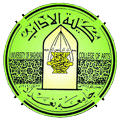The Educational system in Iraq witnessed a series of developments that led to the emergence of the Faculty of Arts in the late first half of the Twentieth century, specifically on March 22-23 1949. Through this long journey , this civilized edifice was honored to carry the banner of thoughts and culture with all its ability and competence to contribute to community service. In the field of humanities and linguistics, providing the students with the knowledge of science, skills, and thoughts to achieve the lofty and noble goals that would serve all humanity. The project started with the emergence of the idea of establishing a University in the forties of the last century to empower the pioneering role of scientific research, after establishing a group of Colleges to achieve a professional and lofty goal. The establishment of these colleges was to prepare employees or specialists in certain professions due to an immediate need. In 1943, the government issued an order to form the first committee to study the project of establishing Baghdad University. The committee was headed by the British expert, Mr. (Hamley), who indicated the importance of establishing the University and recommending the establishment of its first College, which is (the College of Arts and Sciences). The main goal of the College of Arts and Science would be to take care of literature and liberal sciences without being restricted to graduating specialized professionals. The College of Arts and Sciences was the first pioneering University for education in Iraq, which is the real nucleus of the University of Baghdad. The study continued in this college until the enactment of the Baghdad University Law in September 1956, according to which the university was officially established, but the law remained suspended and did not begin to be implemented until the end of 1957. After a short period, specifically in 1958, the Faculty of Arts and the Faculty of Science were separated. It was (the College of Arts) when it was founded, and it included three departments: Arabic Language and Literature, Social Studies (History and Geography), and Philosophy, then other departments were added to it, bringing a total of seven departments: Arabic language, English language, antiquities, and civilization for the year 1951and Economics, History, Geography, and Sociology for the year 1952, but in the year 1954, the Department of Philosophy was cancelled. In 1959, two new departments were opened, namely the Department of Kurdish Language and the Department of Political Science, and in the year1960, the Department of Philosophy was reopened, and the Department of Political Science and Law was disbanded in the Faculty of Economics and Political Science in the year 1962. In 1963, the Department of Kurdish Language was attached to the College of Languages. In 1964, the Department of Journalism was established for the first time, and it was reorganized and renamed (the Department of Media), which was later separated from the College under the name of the College of Mass Communication in the year 2003. In1969, the College of Languages, Girls, Education, and Sharia was merged into the College of Arts, and as a result, the Department of European Languages was created, which was separated in the year 1980 from the Department of English Language, the Department of Oriental Studies (Turkish, Hebrew, Persian) and the Department of Religion, which merged in1972.
In1988, the Department of Eastern and European Languages separated from Literature and Law in the College of Languages after its development and the conversion of the Kurdish Language Department to the College of Education and the Department of Fundamentals of Religion became independent under the name Faculty of Sharia, in the year 1974, the Department of Psychology was introduced.
The College of Arts was distinguished by its cultural activity in all areas of human knowledge. Important seminars and conferences were held in it. It also had a cultural season, which was revived recently, and presented a series of monthly seminars, including the Department of Sociology. The College of Arts occupied the building opposite the Technical Medical Institute in Bab al-Mu’azzam at the time of its foundation, then moved in the year (1956) to the building occupied by the College of Law. College of Commerce, which is the current building. In the College of Arts, the first building blocks for postgraduate studies in Iraq were laid, specifically in the Department of History in the year (1960-1961) for a Master’s study, and a doctoral study was opened in the year (1972) in the departments (history, geography, and Arabic language). The general average number of postgraduate students in the college is about 700 students. A peer-reviewed scientific journal is issued by the Faculty of Arts, which is (Journal of Arts), whose first issue was published in June of the year1959, and alongside it appeared a journal specializing in history and antiquities. Its first issue was issued in 2000, as well as the periodic bulletin of Literature Visions issued by the Media and Public Relations Unit in the College of Arts, whose first issue was published in 2010. The Faculty of Arts is one of the unique faculties that has been able to preserve the university traditions and has provided the Iraqi cultural scene with brilliant names and solid scientific results.
Iraqis, Arabs and foreigners, and the pillars of Iraqi and Arab knowledge and culture are graduates of this college such as Taha Baqir, Jawad Ali, Ali Jawad al-Taher, Ali al-Wardi, Jaafar Khasbak, Yassin Khalil, Khalil Ammash, Ibrahim Shawkat, Jassim Muhammad al-Khalaf, Anad Ghazwan, Saleh Ahmed al-Ali, Sami Saeed al-Ahmad, Madani Saleh, Kamel al-Shaibi, Hussam al-Alusi, Qais al-Nuri, Mutaib Manaf al-Samarrai And Alaa al-Bayati and Kamal Mazhar and the list is very long.
